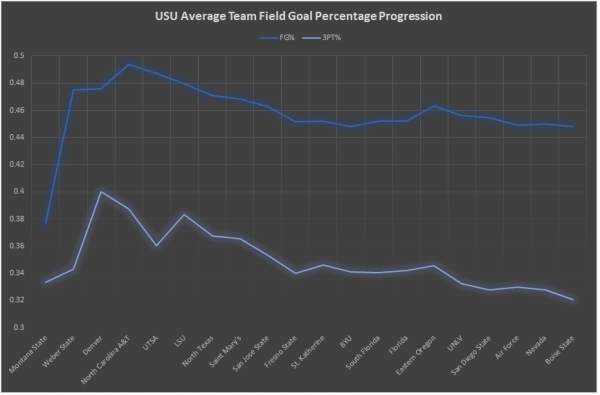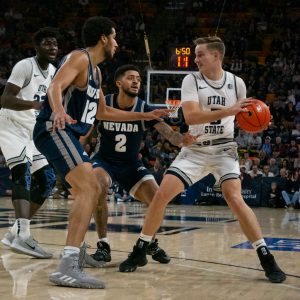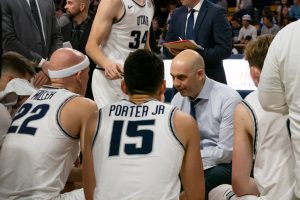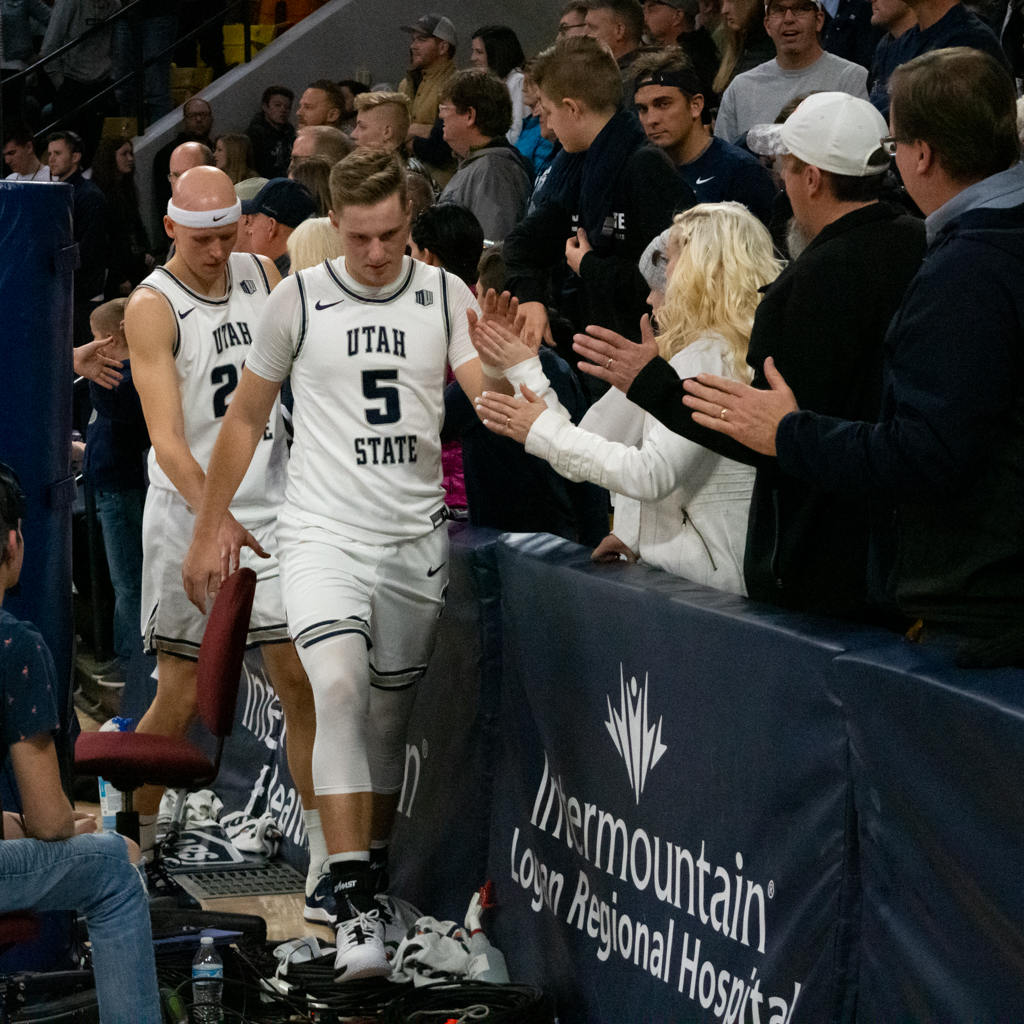State of USU hoops Part 1: The Struggles
Utah State recently hit rock-bottom.
Yes, the team that is currently eight games above .500, ranks in the top 25 in at least 10 statistical categories, and is the reigning Mountain West regular season and tournament champions that returned four starters and six overall rotation players from that title-winning squad.
That team has found the bottom of the well.
Just a few short weeks ago, the thought of USU being in this kind of position was ludicrous. On Christmas Day, the Aggies owned a 12-2 record. The only two losses were to solid teams — Saint Mary’s and BYU — and both were incredibly close games. A few days later, three days before the new year, Utah State plastered Eastern Oregon 129-61, tallying its second-highest point total in program history. A feat they accomplished with leading scorer, Sam Merrill, and top center Neemias Queta, resting on the bench in street clothes.
Move 21 days down the road from the cruise party against Eastern Oregon and the Aggies were in dire straits.
This tumble into the darkness arrived on scene much like the “Jaws” theme. The first discordant sounds were little more than a blip on the radar — Utah State had one poor shooting half at Jamaica vs LSU and then a below-average offensive night against North Texas.
But the notes don’t stop. A few more chords play, deepening the uneasy feeling — a loss to Saint Mary’s, underwhelming performances against below-.500 teams San Jose State and Fresno State. Gradually the music builds upon the unpleasant notes, elongating and deepening them — another loss, this time to rival BYU, barely hanging on by threads against South Florida and the reeling Florida Gators.
Before long, a few, disconnected, haphazard and unpleasant chords have erupted into a cacophony of sound, surrounding the listener, trapping them in a ring of existential terror, unable to escape what once seemed easy to ignore until all hope seems lost and the end of days is at hand.
And that’s where the Aggies sat just a short time ago. Though they made it through 15 games with just two losses, that memory has been completely drowned out by the deafening roar of four losses in five outings. The most recent being a collapse for the ages against Boise State.
How and why all of this came about is a long and lengthy case to unpack. Each individual aspect could be expounded on for pages upon pages. Putting them all together in a comprehensive form could be a graduate thesis. Finding the solution to all these problems could akin to finding the Holy Grail in the bushes by the Dee Glen Smith Spectrum.
The most prevalent issue revolves around Utah State’s shooting, or lack thereof to be specific. And as explained in the cheesy Jaws analogy, this has been an issue long in the making. To explain it, the season needs to be split into two main segments, the first segment being USU’s first six games, the sixth game being the Aggies’ win over LSU. Segment two is the remaining contest, games seven through 20 running through this past Saturday.
In that first season segment, Utah State scored 80 points in each game — six straight contests, just the second time that’s been done in program history — for an average of 85.0 points. To get there, the Aggies shot 48.0 percent from the field, 51st in the NCAA at the time. The team’s 3-point percentage was even better relative to the rest of the collegiate world, sitting at 38.3 percent, or 45th among 350 Division I squads.
After that, however, the wheels didn’t so much fall off as they instantly dematerialized into the ether.
The first game of segment two, in Jamaica against North Texas, kicked off the trend of not being able to shoot the ball into the ocean. Against LSU, the Aggies had one bad shooting half, but they put two of those poor halves together for a night where they made only 40.4 percent of their shots including a frightening 3 for 14 (21.4 percent) effort from downtown.
Delving further and shifting farther away from the first six games into contests 7-20, Utah State saw itself drop from effectively the top 50 in two major offensive efficiency statistics to 193rd in overall shooting percentage and 316th in 3-point percentage when isolating the 7-20 game span.

Another damming stat during these stretches is rebounding. Again, a glaring difference lies in the first six games to the ensuing games. Excluding games against Saint Katherine and Eastern Oregon for the enormous outliers they are, the Aggies went from outrebounding foes by just over 14 boards per game in the six-game span to an advantage less than one at 0.4 in the remaining games.
It is logical to assume that since Utah State missed so many more shots in the latter season segment, that opponents would get an artificial boost that can be accounted for. Perhaps, but it does not explain how USU grabbed 44.7 rebounds to start the season and then dropped by nearly 10 boards per game to 35.8.
The Aggies went from not being outrebounded by anyone to losing the battle on the glass to Saint Mary’s, Florida, UNLV, San Diego State and Air Force. Notice a trend in those games? Utah State’s point differential in those games is -50 (average of -10) with just one win.
Defensively, there haven’t been many concerns, even in the troublesome second segment of the season. At least that was the case until recently. In the five games prior to Air Force, Utah State has given up 76.8 points per game, a far cry from the 61.9 allowed in the first 15 outings of the season.
An intriguing, but also disturbing note that should be made is that USU played very good defense against Nevada and Boise State for 36 minutes. The more astute will notice the four missing minutes that complete a standard 40-minute regulation college basketball game.
Combining the two more recent game’s final four-minute stretches (and overtime at Boise State), the Aggies allowed their two foes to shoot 20 for 22, or 90.9 percent and 10 for 11 from deep, also 90.9 percent. The Broncos closed out regulation by making nine consecutive field goals while the Wolf Pack missed a singular shot down the stretch.
Against Nevada, the lack of defense was far more benign and much less catastrophic. Mainly, because Utah State attempted 21 free throws over the same span that Nevada went on its offensive tear. Boise State was a much different story. The Aggies attempted 10 free throws in the final 35 seconds, but BSU had already caught up thanks to USU missing 10 straight shots in the last five minutes. From there, the Broncos made threes while the Aggies made free throws, allowing the game to go into overtime.
Utah State has shown the ability to close out close contests. They’ve done it five times to date against LSU, North Texas, Fresno State, South Florida and Florida. But now in at least four games, lack of clutch play has directly resulted in a loss.
Poor team basketball has been thoroughly explored here, but some individual performances need to be examined as well. Let’s start at the top with Sam Merrill.
—
Merrill is having an okay season, given his caliber. He’s leading the team in points (17.7), is second in assists (3.6) and third in rebounds (4.8). He’s actually on pace to be the only Aggie in the last quarter-century to average at least 17 points, 4.5 rebounds and 3.5 assists (mind you that includes his conference Player of the Year-earning 2018-19 season). However, there’s a little more to his 2019-20 efforts.
The main thing with Merrill is that he’s not shooting the ball well. It’s not just his lofty standards, either. As of late, his shooting hasn’t held up to your average college basketball player.

Sam Merrill playing for USU at their game against Nevada on January 11, 2020. Merrill played 38 of this game’s minutes, playing a total of 3,815 minutes his whole career, putting him in 5th place for minutes played in a career at USU.
His season 3-point average of 38.9 percent — higher than last year’s rate from deep — is rather deceptive. It’s propped up by his 54.8 percent shooting on 5.2 attempts in the first six games of the season. Given how far the percentage rate has dropped, you can guess what’s coming. In the 12 games he’s played since LSU, Merrill’s 3-point percentage is 32.5.
The thing is, Merrill hasn’t really strung together good shooting at any point this season and his scoring has suffered. In case you missed it, his scoring is down 3.2 points per game from last year’s 20.9. Merrill’s early-season 3-point shooting was out-of-this-world good, but when he stepped inside the arc, that golden touch went away.
In those first six blissful games, Merrill offset his 3-point numbers with a sub-40 percent mark on 2-pointers; just 33.3 percent. Once a good below-the-rim finisher, Merrill kicked off the year by making 41.7 percent (10 of 24) of his layups.
LAYUPS.
Merrill has since kind of reversed his poor 2-point shooting, making 47.6 percent of those shots since his unimaginably poor start. Keep in mind that Merrill was a career 52.2 percent shooter inside the 3-point line coming into the season. But his 3-point shooting has also since tumbled.
Against Boise State, Merrill had his first 30-point outing of the season, but that was marred by the fact that he missed his final five shots of the game, four of which were 3-pointers. In the last 4:50 of regulation and OT, Merrill went 0 for 5 from the floor with two turnovers. When push came to shove, he just didn’t execute. He made almost no poor choices, he just couldn’t make the shots fall. And in a make-or-miss situation, that’s what matters in the end.
Struggles are far from limited to Merrill, though, and the healthy amount of blame that falls to him is generally only given as a product of being the emotional and on-court production leader of the team. Every player on the team can have his season examined and a significant drop-off found.
Diogo Brito’s individual free-fall is probably the most concerning. In the Craig Smith era, the Aggies are undefeated when Brito tallies double-digit scoring numbers. That makes his post-Saint Katherine scoring average of 5.2 points downright alarming given he was at 11.3 up until Dec. 10. Brito’s shooting numbers in his last nine games — 23.7 percent overall and 12.2 from deep — are nowhere near his typical form.

Coach Smith consults with his players during a time-out during the USU vs. Nevada men’s basketball game on January 11, 2020. USU won this game 80-70.
The other backcourt contributors, Abel Porter and Brock Miller, fare little better. Though thankfully, they are doing better. Miller’s 35.4 percent shooting from beyond the arc last season is down to an even 31, and he’s chucking up 6.5 of these per game. Take away his two best games (out of 20), and his 3-point percentage for the year is 26.7. Porter is averaging 7.2 points on 41.9 percent shooting, 33.3 from deep. That’s down from 8.1 points, and 45.5 percent shooting on 3-pointers and 43.6 percent overall in 17 starts last season.
Alphonso Anderson’s toils are up there with Brito’s for most concerning. Early-season Anderson was a revelation, masterfully bringing elite value from the bench. Through seven games, he was third in the NCAA among bench players in points per game (14.7), second in rebounds (6.3), and the only reserve man to average 14 and 6 so far on the season.
Even after the elite off-the-bench play in early games, Anderson didn’t drop off all that much. Between Saint Mary’s and Eastern Oregon, his numbers were still good — 9.5 points, 4.0 rebounds, 1.5 assists and 1.0 steals — especially considering his role and the increase in opponent quality. The drop was even justifiable given the lofty stats early on.
However, the past five games, Anderson has disappeared off the face of the earth. For one, his minutes are down. From 24.5 minutes a night for 15 games, the junior college transfer is at 13.8 these past five outings, including a season-low six against San Diego State.
The high value once seen out of Anderson has fallen as much as his minutes as of late. He’s making 31.8 percent of shots since the start of the new year and has yet to make a free throw after being an 86 percent shooter at the charity strip in late November.
The only players escaping the never-ending list of troubles are those simply not seeing the court enough to play bad — Sean Bairstow, Trevin Dorius, Kuba Karwowski, and also Neemias Queta with his preseason injury — and Justin Bean. To be honest, even Bean had his stretch of struggles, but so far it seems to be mercifully limited to just three games. Against SDSU, Air Force and Nevada, Bean averaged a mere 5.7 points and 4.3 rebounds (though he still had a good shooting percentage of 47.1). But in the remaining 17 times Bean has taken to the court, he’s posting paint-dominating stats of 14.4 points and 11.4 rebounds per game on 51.4 percent shooting.
Smith summed all of this up lightly after practice earlier this week. He said the team has “hit a rough patch in 2020.”
“At the end of the day, we need to keep grinding and get better,” Smith said. “We use a lot of boxing analogies. The regular season in Mountain West play is an 18-round fight. There are 18 games and we are not even halfway through. There is a lot of season out there. We have time to keep getting better. The last two days we have gotten better.”
There’s no doubt the more recent games are more problematic because of what showed on the scoreboard after 40 minutes. But these problems festered unheeded for a good third of the year before they finally caught up to the Aggies and became an issue. Where Smith takes this team, with the help of Merrill and Queta, is yet to be seen. One win here and a solid performance there won’t solve these issue, that became evident after USU appeared to bounce back with a win over Nevada.
Ultimately, where and how these issues came from is immaterial, be it buckling under preseason hype, overconfidence or perhaps the 2018-19 season was a mere fluke with everyone playing and coaching over their own heads. And trying to guess would amount to nothing more than speculation that helps no one. What matters is where the solutions come from. Smith and his staff are getting paid handsomely by taxpayer dollars and tuition money to do just that.

